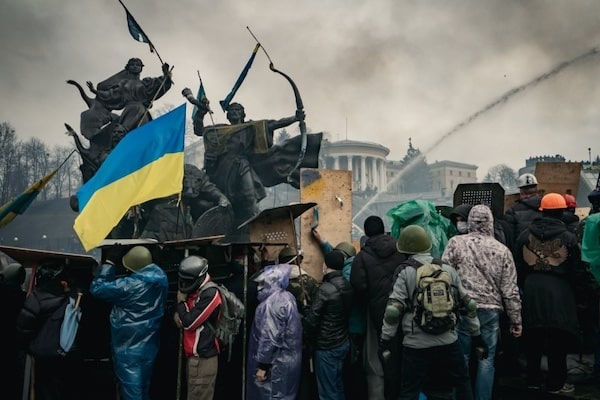A nearly one-million-word verdict from Ukraine’s Maidan massacre trial has recently confirmed that many Maidan activists were shot not by members of Ukraine’s Berkut special police force or other law enforcement personnel but by snipers in the far-right-controlled Hotel Ukraina and other Maidan-controlled locations a decade ago today. The verdict, handed down on October 18, 2023, states specifically that this hotel was controlled by Maidan activists and that an armed, far-right-linked Maidan group was in the hotel and fired from it. It also confirms that there was no Russian involvement in the massacre and that no massacre orders were issued by then President Viktor Yanukovych or his ministers. The verdict concludes that the Euromaidan was at the time of this massacre not a peaceful protest but a “rebellion” that involved the killing of Berkut and other police personnel.
This is an important official acknowledgement, not only because the violence represented the most significant case of mass murder, violent crime, and human rights violations in independent Ukraine to that point, but also because of the subsequent conflicts to which it has led or contributed. Notably, the massacre precipitated the violent overthrow of Yanukovych and his government, who were falsely blamed for carrying it out. It then spiralled into the Russian annexation of Crimea, the subsequent civil war and Russian interventions in the Donbas, and the conflicts between Ukraine and Russia, and between Russia and the Western powers, which Russia dramatically escalated with its illegal invasion of Ukraine on February 24, 2022.
There has been, however, a blackout of the verdict’s confirmation of the Maidan snipers in the Ukrainian media and, with a few notable exceptions, the Western mainstream media. Moreover, in an op-ed piece in The Bulwark, an online neoconservative magazine, author Cathy Young misrepresented the verdict, falsely claiming that it had found the Berkut police responsible for the deaths of 40 of the 48 protesters killed. Young also denied and openly whitewashed the existence of Maidan snipers and the far-right’s involvement in the Maidan massacre, labelling it a “conspiracy theory” despite clear and overwhelming evidence to the contrary in the verdict, the trial, and the investigation, as well as in academic studies of the event. Such deliberate omission and misrepresentation has been perpetrated in spite of the fact that the verdict’s Ukrainian text, as well as automatic English translation of the relevant excerpts, are publicly available, and in spite viral tweets describing and quoting from it.
The verdict by the Ukrainian Sviatoshyn District Court in Kyiv, along with the findings of the investigation by the Ukrainian prosecutor general’s office (GPU), comprise a de facto official admission—on the part of Ukraine’s justice system no less, which cannot be called independent—that on February 20, 2014, at least 10 of the 48 Maidan activists killed, and 115 of the 172 wounded, were shot not by Berkut or other law enforcement personnel firing from government-controlled areas but by Maidan snipers operating in Maidan-controlled locations. The government investigation admitted that one dead protester and 77 wounded Maidan activists were not shot from Berkut-controlled sectors, and therefore did not charge anyone for those crimes. Of course, it stands to reason that if these activists were not shot by government personnel, they must have been shot by the Maidan snipers.
The verdict, issued by the Kyiv court shortly before the tenth anniversary of the Euromaidan, shows that the Maidan massacre narrative that has been propagated by governments, the mainstream media, and a variety of info-warriors in the West and in Ukraine is false. The proponents of this narrative have called the Maidan a peaceful protest and presented the massacre of the Maidan protesters as a crime perpetrated by government snipers on the orders of Yanukovych and his government. The prosecution, the victims’ lawyers, the New York Times and other mainstream media (with some notable exceptions), Wikipedia, self-proclaimed experts, and info-warriors denied the presence of snipers in the Hotel Ukraina and other Maidan-controlled buildings, the shooting of Maidan protesters by these snipers, and the far-right’s involvement in this mass killing, and claimed instead that such ideas comprise a “conspiracy theory” and “Russian disinformation.” The exceptions included reports by ARD, BBC, The Nation, Jacobin, Court House News, Ekathimerini(Greece), Jyllands-Posten (Denmark), Weltwoche (Switzerland), Il Fatto Quotidiano (Italy), and El Nacional (Spain)—in addition to Canadian Dimension, which has published some of my other writing on this subject.
Massacre of activists and shooting of journalists by snipers in the Hotel Ukraina
The verdict states that “based, even only on” 19 trial testimonies about the shooting from this hotel, including testimonies by victims who stated that they were wounded “from the area of the ‘Ukraine hotel’” and “objective data on gunshot wounds from the side of the hotel” of one killed and one wounded protester there was enough data to make “a categorical conclusion that on the morning of February 20, 2014, persons with weapons, from which the shots were fired, were in the premises of the Hotel Ukraina.” The trial decision specifies that nine Maidan protesters were killed and 23 wounded by “unknown persons” who were not “law enforcement officers,” and that there exists a lack of evidence for the involvement of the Berkut police (five of whom were charged for the crimes) in these killings and woundings. The decision also states explicitly that at least six specific protesters were killed and many others wounded by shots fired from the Hotel Ukraina and other Maidan-controlled locations, and that this was “the territory that was not controlled by law enforcement agencies at that time.”
This means that the victims were instead shot by snipers firing from Maidan-controlled locations, since the verdict confirms the findings of existing academic studies and the government investigation, specifying that Russian agents, whose presence in Ukraine was investigated and tracked, “did not have any participation” in the massacre. In the verdict, the trial judges and jury stated explicitly that during the massacre of the protesters, the Hotel Ukraina was “controlled by the activists,” that the Maidan activists in the hotel were armed with hunting rifles and a Kalashnikov-type assault rifle, that these activists shot from the hotel specifically targeting a BBC TV crew, and that at least three Maidan activists were deliberately killed by shots fired from the hotel.
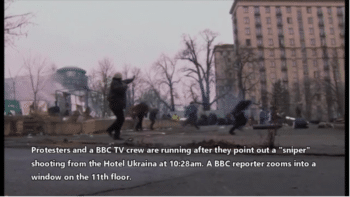
The verdict confirms that a BBC TV crew was targeted by a Maidan sniper firing from the “activist-controlled” Hotel Ukraina. Screen grab from Video C/YouTube.
The verdict confirms that a former member of the Ukrainian parliament, who is also a far-right activist, was filmed by a French TV crew in the Hotel Ukraina as he “provide[d] passage for activists” who were holding firearms that looked like “a Kalashnikov assault rifle and a hunting rifle.” A statement by the far-right Svoboda party asserts that it took control of the Hotel Ukraina, while videos and testimony by the head of the Maidan group guarding the hotel before, during, and after the massacre, as well as testimony by the hotel staff, indicate that this far-right group controlled and defended the hotel. Videos and trial testimony by Spilno TV, a pro-Maidan Ukrainian streaming group, show that a far-right-linked group of Maidan snipers was on the upper floors of the hotel and shot at the protesters.
The verdict states that a BBC video “captures the shelling from the side of the Ukraina Hotel building of the camera crew of BBC journalists (a single shot is heard) … and in the premises of the Ukraina Hotel, an activist is recorded with … [a] pistol-type firearm.” The decision by the judges and jury evaluated this video “as documented data from the activist-controlled building of the Ukraina Hotel in Kyiv about the targeted use by the activists of objects that, by their external features, are clearly similar to firearms, weapons of the type of hunting weapons.” The Ukrainian government investigation revealed that a deputy of the far-right Svoboda party was living in a Hotel Ukraina room from which the BBC crew was shot. ICTV had filmed from the massacre site on the ground snipers in the same hotel room shooting Maidan protesters in the back. A Maidan activist testified at the trial that following this shooting, protesters told him that these were “our snipers.”
According to the verdict, a gunshot from the Hotel Ukraina hit a tree behind a group of Maidan activists, and two activists were killed and one wounded by shots fired from the hotel. An edited Belgian TV video of this massacre, and the luring of two Maidan activists to the site where they would be murdered, was presented by major TV networks in the Western countries and Ukraine as a massacre committed by government snipers or Berkut police.
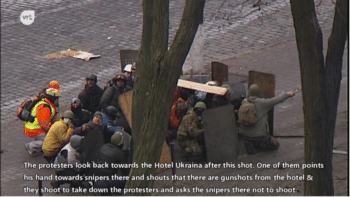
The verdict confirms the shooting of Maidan activists from the “activist-controlled” Hotel Ukraina. Screen grab from Video C/YouTube.
The verdict notes that the victim, “who was also in the mentioned group of activists,” “was wounded in the back from the hotel,” as he himself testified, and that another victim from the same group was fatally wounded “from the upper floors of the ‘Ukraine’ hotel.” It specifies further that “within the scope of this court proceeding, data on the involvement of law enforcement officers in such an injury to the victim, and even more so the accused, have not been established” and that “the gunshot wound was inflicted on PERSON_1852 [a man named Volodymyr Zherebnyi] from the direction of the ‘Ukraine’ hotel, that is, from the territory that was not controlled by law enforcement agencies at that time.” As the verdict states,
this shot was aimed at a crowd of people.
The verdict also states that “fatal gunshot wounds to the body (chest and abdomen) were received by PERSON_1770 [Oleh Ushnevych] from the side of the hotel ‘INFORMATION_161’ [the Hotel Ukraina] and the area in front of it, which were not under the control of law enforcement agencies, and hence the involvement of the accused and RSP [Berkut special company] fighters in them, and as a result, the victim’s death, is excluded” (because the verdict claimed, bizarrely, that he was also then wounded in the leg by a Berkut officer, Ushnevych was not included in a list of slain protesters whose killings showed no evidence of involvement by the Berkut or other government forces).
Massacre of protesters and police, and shooting at German journalists by snipers in Maidan-controlled areas
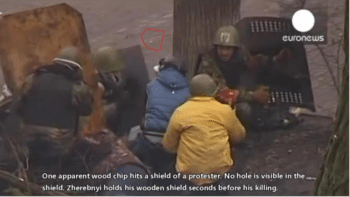
The verdict confirms the killing of Volodymyr Zherebnyi and the wounding of Volodymyr Venchak, on the ground near Zherebnyi, from the Hotel Ukraina. Screen grab from Video C/YouTube.
The verdict also confirms that the Maidan massacre on February 20 began with the killing of three and wounding of 39 Berkut and Internal Troops officers (the latter was a uniformed gendarmerie under the control of Ukraine’s Internal Affairs Ministry), none of whom were armed. It refers to those who shot these officers as “unknown persons,” but the presiding judge admitted in an interview with Ukrainian media that the verdict is referring to members of the far-right-linked group of Maidan snipers. A few of the snipers also admitted, in Ukrainian media interviews, to shooting and killing the police officers from the Music Conservatory building.
The verdict specifies that there is evidence for the killings of at least three other Maidan activists from Maidan-controlled locations, while involvement by the Berkut and other law enforcement has either been ruled out or remains unproven. It cites evidence for the killing of one activist from the Music Conservatory, which was the headquarters of a group of Maidan snipers linked to the Right Sector, a Ukrainian far-right organization, and which included Svoboda activists. The trial decision confirms that the Music Conservatory was then occupied by Maidan “activists” led by the commander of this far-right group, who subsequently became a member of the Ukrainian parliament following the Maidan events. The verdict also indicates that two rooms in the Hotel Ukraina were shot at from the Music Conservatory and the neighbouring Central Post Office, but omits the facts that these rooms were occupied by German ARD TV journalists and that the Central Post Office was then serving as the Right Sector headquarters.
The trial decision also cites evidence that Ihor Kostenko was killed neither by the Berkut nor other law enforcement agents, but from a Maidan-controlled location. The decision notes that Kostenko,
a few seconds before his fatal wound, together with other bystanders, watched the windows of the Hotel Ukraina … and this attention, united by joint observation of the source of possible danger, did not stop on the part of all observers even after the injury of PERSON_1708 [Kostenko], when he was already lying on the asphalt.
Besides being a Maidan activist, Kostenko was a Wikipedia author and editor. It is revealing that Wikipedia deliberately omits that he was killed by sniper fire from the Maidan-controlled area. It is hardly coincidental that the same Wikipedia editors who deliberately and literally misrepresent and whitewash the false-flag Maidan massacre also systematically misrepresent and whitewash the far-right in Ukraine and its involvement in the Holocaust. These editors include Wise2, also known as Prohoshka, who has also propagated “scientific anti-Semitism” and whitewashed the involvement of the Organisation of Ukrainian Nationalists (OUN) in the 1941 Lviv pogroms during the Nazi occupation of Ukraine, justifying it on the basis of “Jewish collaboration.” Another Wikipedia editor, who uses the handle My Very Best Wishes, brazenly whitewashed the fact that monuments in Canada to the Galicia Division and Roman Shukhevych are in fact commemorating a division of the Waffen-SS and a Nazi collaborator. A scholarly article by a noted historian at the University of Ottawa also listed My Very Best Wishes as one of the editors involved in an intentional distortion of Wikipedia’s history of the Holocaust in Poland. This editor also recently wrote, falsely, on Wikipedia’s biographical page on Elon Musk about the latter’s supposed “involvement in the Russian invasion of Ukraine.” Various publications and websites have identified Wise2/Prohoshka as a far-right Svoboda activist named Svyatoslav Gut, and My Very Best Wishes as Andrei Lomize, a biophysics researcher at the University of Michigan.

Memorial to protesters killed in the Maidan massacre in Kyiv. (Photo: Wikimedia Commons)
The verdict also confirms that the first three activists killed were shot with pellets of a type used for hunting, at a time before the Berkut unit, whose five members were falsely charged with the killings, had even been deployed. It explicitly states that at least one of these activists was shot from the Maidan-controlled area by one of the Maidan shooters using a hunting rifle.
Fabricated evidence against Berkut, no massacre order by Yanukovych
The trial verdict also confirms the absence of evidence for any order by Yanukovych or his government to massacre the Maidan protesters. This is a crucial official acknowledgment, since Yanukovych and his government were overthrown on the basis of accusations of having ordered the massacre. Joe Biden, then U.S. vice-president, wrote in his memoirs that during the Maidan massacre, he called Yanukovych and told him that “it was over; time for him to call off his gunmen and walk away,” that he “had lost the confidence of the Ukrainian people … and he was going to be judged harshly by history if he kept killing them.”
In addition to acquitting two Berkut policemen for killing and wounding the Maidan activists, the verdict states that all five accused Berkut officers had been blamed, baselessly, for killing 13 Maidan protesters and wounding another 29. This is further evidence of trumped-up, politically motivated charges.
The decision to convict in absentia three Berkut officers, who had been transferred by Zelensky to the Donbas separatists in a 2019 exchange, is a political one. The charging of these officers for the murders of 31 of 48 Maidan protesters killed, and the attempted murders of another 44 of 80, was based on a single, fabricated forensic examination, not to mention posited on the notion of collective responsibility. This single forensic examination of bullets, undertaken five years after the massacre, reversed the results of some 40 earlier forensic bullet examinations, including a computer-based examination which showed that bullets taken from the bodies of killed Maidan protesters did not match the Berkut Kalashnikov rifles. The recent Maidan massacre trial verdict has dismissed the single bullet match from the fraudulent forensic examination, supposed to have linked a convicted Berkut officer to a killed protester, as it was based on a bullet fragment that had appeared on the scene without any trace of corresponding pieces from the same bullet—a sign of evidence tampering. Nonetheless, on the basis of such forensic “evidence,” the decision to convict the Berkut officers had been taken.
The three Berkut policemen were convicted in absentia based on this single, fabricated forensic examination as well as on their presumed collective responsibility for the murders of 31 protesters and the attempted murders of 44 more. On the same basis and contrary to all other evidence, a Berkut commander was also convicted of the manslaughter of four protesters and the wounding of another eight, for supposedly having ordered his officers to fire indiscriminately during the evacuation of internal troops by the Berkut company, and its subsequent retreat after one Berkut officer was killed and another wounded. The decision attributes the killings and woundings of most of these protesters to Berkut or unidentified police officers, even in cases without bullet-to-gun matches, simply because these protesters were killed in the same group and in approximately the same time and place. This was done even though the trial verdict convicting the officers admitted that people in the same groups of protesters had been killed and wounded, at about the same time and place, not by law enforcement but by “unknown persons” located in the Hotel Ukraina and other Maidan-controlled buildings and areas.
The fabricated forensic bullet examination also contradicts synchronized videos which clearly show that Berkut officers had not been shooting at the specific times when almost all of the Maidan activists were killed. It also contradicts on-site investigations by government ballistics experts, pointing to bullet trajectories originating from Maidan-controlled areas; as well as the results of forensic medical examinations tracking bullet trajectories based on the victims’ wounds as seen from the top, back, and side; and the testimonies of the great majority of the wounded Maidan protesters, and of several hundred prosecution and defence witnesses and other witnesses, concerning snipers in the Hotel Ukraina and other Maidan-controlled locations. All this evidence demonstrates clearly that the Berkut policemen could not physically have shot these protesters. Indeed, these Berkut policemen were filmed shooting neither at the specific time the protesters were killed nor in their specific direction. Bullet-hole locations and wound trajectories showed that the protesters had been shot not at low angles, which would have been consistent with the Berkut barricade positions on the ground in front of the protesters, but at steep angles and from areas to the side or the rear, corresponding to the Maidan-controlled buildings or other buildings in Maidan-controlled areas.
Synchronized videos reveal that the single match in this forensic examination—a bullet taken from the body of a wounded Maidan activist linked to the Kalashnikov of a convicted Berkut member—was clearly fabricated, since the convicted policeman was filmed not shooting at the time when this protester (who himself testified that he had been shot from the Hotel Ukraina) was wounded. A government forensic expert determined that the protester had been shot from the top of the hotel, based both on the position of bullet holes in the chair he had been using to shield himself from the Hotel Ukraina snipers, and on the steep angle of his wound trajectory. Synchronized video shows that at the very time of his wounding while on a pedestrian bridge, protesters hiding beneath the bridge were pointing toward snipers in the Hotel Ukraina as the latter shot at protesters on the bridge.
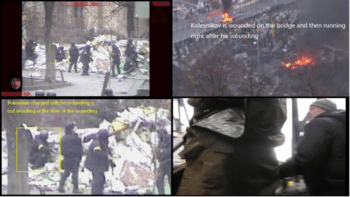
Evidence that the conviction of a Berkut officer was based on a fraudulent forensic match between the officer’s AKM rifle and the bullet that struck a protester. Screen grab from Video D/YouTube.
The difference between those times when Berkut officers were shooting and those when specific protesters were killed has also been confirmed by video synchronizations produced by an anonymous group funded by the prosecutor general’s office (GPU), with the involvement of a propaganda outlet of Maidan politicians accused of organizing the massacre, as well as by Carnegie Mellon University researchers working on the model produced by SITU, a New York City-based research group. But during the trial, these synchronized videos—depicting the times when Berkut officers were shooting and those when protesters were killed—were shown either separately or as a not-easily-discernable combination of 12 videos on a single screen, thereby obscuring the fact that these events took place at different times. In a few cases where gunfire by Berkut officers coincided with killings of protesters, these moments also coincided with the sound of other gunshots, i.e., by the Maidan snipers. But the verdict from the Berkut officers’ trial used this deliberately misleading compilation, devised by an anonymous group linked to accused organizers of the massacre, as a proof of the Berkut officers’ guilt, even though, in fact, it constitutes clear proof that the officers were not guilty in the absolute majority of these cases (although in a few cases, shootings of protesters by Berkut officers engaged in a crossfire with Maidan snipers, or as result of ricochets, cannot be excluded).
The recent Maidan trial verdict has also revealed that the Maidan lawyers, in the end, did not present the SITU 3D model during the recent trial, even after wasting court and jury time by introducing it. This confirms again the fact that the model was unreliable, having been based on a primitive fraud in which the victims’ wound locations, which in fact accorded with the direction of gunfire from Maidan-controlled buildings, were altered to accord instead with Berkut positions on the ground. The SITU model, which was produced for the trial by a New York architectural research group by order of the Maidan lawyers at a cost of nearly $100,000, was used to propagate disinformation in articles published in the New York Times and other Western and Ukrainian media. This 3D model, like the salaries of the Maidan lawyers and even prosecutors’ visits, was paid for by billionaire George Soros’s Open Society Foundations in Ukraine.
The official admission that the great majority of Maidan activists were not killed or wounded by government forces is evidence, in and of itself, to suggest that the majority of the protesters shot were instead killed or wounded by Maidan snipers, since they were shot at the same time and in the same place. To falsely blame the Berkut for these killings is easy, because murdered people cannot testify. Of those wounded, however, the overwhelming majority testified to witnessing snipers and/or being shot by snipers operating in the Maidan-controlled buildings and areas.
The verdict means that a decade since this crucial massacre—one of the most documented cases of mass killing in history—nobody is in prison for the murders and attempted murders of Maidan activists and police officers, or for shooting at foreign journalists. The silence on the part of those who deny the false-flag Maidan massacre, who call these claims a “conspiracy theory” and thereby whitewash the mass murderers of the far-right, is both deafening and revealing.
Media blackout and whitewash
All Ukrainian media reports omitted the verdict’s confirmations of the false-flag massacre. The Western media (with a few notable exceptions) also omitted this information. Moreover, writer Cathy Young, mentioned above, deliberately misrepresented the Maidan massacre trial verdict, branding the revelations about Maidan snipers operating in the Hotel Ukraina a “conspiracy theory” and claiming, falsely, that the verdict did not indicate that Maidan protesters were shot from the hotel or other Maidan-controlled locations, and that it did not disprove involvement by Russian snipers. Young has further falsely claimed that the Hotel Ukraina was not controlled by the Maidan activists and has propagated instead an actual conspiracy theory that police in the hotel could have shot the protesters. Her claims in these regards are contrary not only to the verdict but also to a statement from the far-right Svoboda party about taking control of the hotel prior to the massacre, to videos of Maidan snipers shooting at protesters and a BBC crew from the hotel, to testimonies both by hotel staff and by the Maidan unit commander in charge of guarding the hotel, and to other evidence presented in scholarly publications.
Oligarchic and far-right leaders and organizations, including neo-Nazis, who were involved in this false-flag mass killing to seize power in Ukraine, were hailed by Western and Ukrainian politicians, media, and even many academics as heroes and defenders of democracy. They were invited for government visits and talks at universities, including in Canada. Government leaders, journalists, investigators, Maidan lawyers, NGO activists, partisan researchers, and info-warriors who branded the reports of the Maidan snipers and their false-flag massacre a conspiracy theory and propaganda were hailed as defenders of justice and human rights, and given grants by Western governments, foundations, and universities, including even a Nobel Peace Prize.
It is doubtful that any of the above parties will suffer any consequences for such fraud and whitewashing of mass murderers, in particular those of the far-right. Ukraine and Ukrainians continue to suffer the consequences of this massacre, which has spiraled into major conflicts, including the ongoing and devastating Russia-Ukraine war, which is also a dangerous, unwinnable proxy war undertaken by the West against Russia.
Ivan Katchanovski teaches at the School of Political Studies at the University of Ottawa. He is the author of Cleft Countries: Regional Political Divisions and Cultures in Post-Soviet Ukraine and Moldova and co-author of Historical Dictionary of Ukraine (Second Edition) and The Paradox of American Unionism: Why Americans Like Unions More Than Canadians Do, But Join Much Less.

